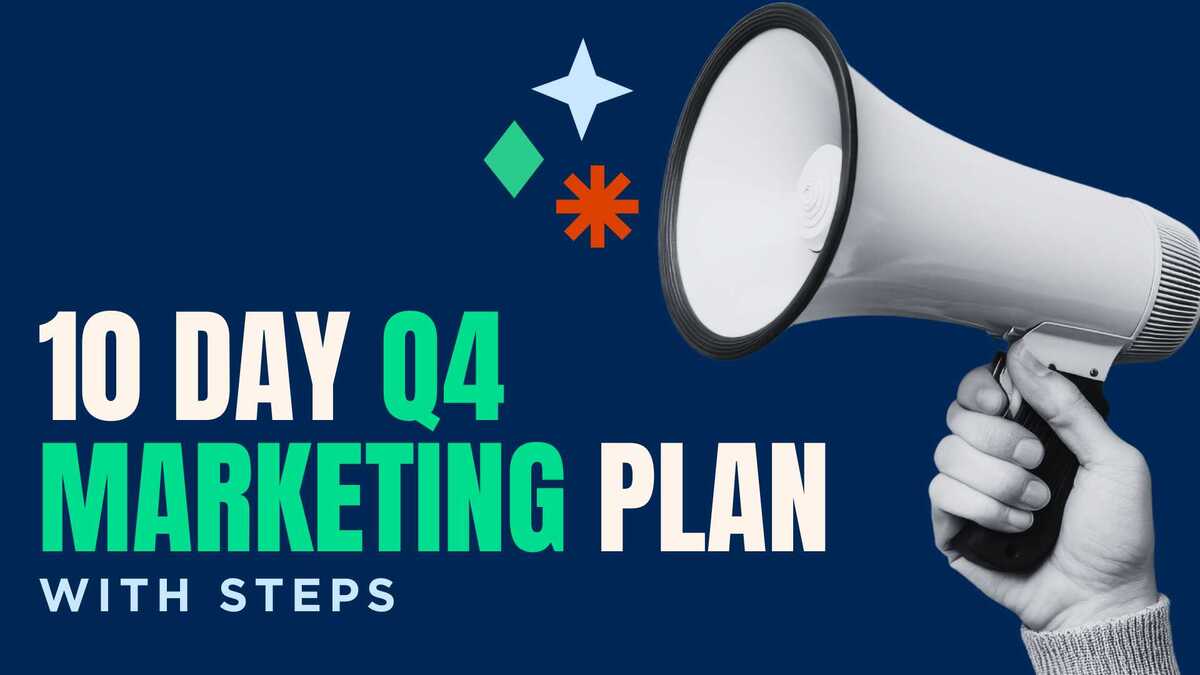blog
10-Day Q4 Marketing Plan with Steps

Are you ready to make Q4 count? It is the shortest and busiest stretch of the year, and small teams often feel the pressure first. Too many ideas compete for attention, deadlines sneak up fast, and campaigns launch without a clear offer or way to track results.
The fastest way to gain control is with a focused plan you can build quickly and start now. In ten days, you can define one goal, shape one time-bound offer, and set the systems to measure every result.
This guide gives you a step-by-step Q4 marketing plan built for speed, clarity, and accountability. You will see how to align your team, focus your channels, and track every outcome so your effort turns into real progress this quarter.

Small Business Marketing Problems and Stakes
For many small teams, October begins with ambition but no clear direction. It’s easy to fill a whiteboard with ideas, yet harder to choose one that ties directly to revenue. The result is energy spent across too many channels without a single story to unify the effort.
Why Plans Stall in October
Marketing often slows down right when it needs to speed up. Three problems appear again and again:
- No single offer to focus the team. Without one clear message, creative and media scatter and customers never see a consistent reason to act.
- Too many ideas spread across too many channels. Testing everything at once splits the budget and dilutes results.
- Unclear ownership and no firm dates. Without decision makers and deadlines, even the best plan stays on paper.
Each of these issues compound over time. Without one goal, teams chase trends. Without clear owners, tasks fall behind. Without deadlines, campaigns launch too late to catch holiday demand.
What You Risk by Waiting
Every day without direction makes Q4 revenue harder to capture. Buyers start planning early, especially for seasonal and holiday purchases. Teams that delay often find competitors already visible where they need to be.
- Holiday-ready buyers move on. Customers who plan early spend early, leaving fewer opportunities later.
- Every day without a plan delays revenue. Missed days in October mean less data and weaker performance in November.
- Teams lose time and morale without direction. Confusion slows production, lowers confidence, and makes it harder to recover mid-quarter.
Momentum is built, not borrowed. Waiting for the “right time” often becomes waiting too long.
The Simple Promise for Fast Results
When pressure builds, clarity is the best strategy. The goal is not to do everything but to execute one focused plan with measurable impact.
A strong 10-day plan includes:
- One goal and one time-bound offer. Everyone works toward a single outcome.
- A compact creative kit and basic conversion tracking. No extras, just the assets needed to launch and learn.
- A fixed launch date within 10 days. Urgency turns preparation into action.
This approach simplifies decision-making and creates space for steady, daily progress.
10-Day October Marketing Plan with Steps and Tracking
This framework gives your team a short path from planning to execution. Each day builds on the last, so you end the ten-day sprint with a live campaign, clear data, and confidence in your results.
Day 0–1: Choose One Revenue Goal
Start with the numbers. Look at the past 90 days to identify what sold fastest and where you have the capacity to fulfill more this month. Then, define a target that connects effort to outcome.
- Review the last 90 days to find your fastest-selling product or service.
- Confirm capacity to fulfill this month.
- Set one numeric target, such as “Close $15K in October.”
A single goal keeps your team aligned and gives every decision a purpose.
Day 1–2: Craft a Time-Bound Offer That Converts
Your offer is the heartbeat of the campaign. Make it clear, urgent, and easy to understand.
- Add a clear end date, for example “Ends October 31.”
- Pick one value lever: bonus, bundle, or modest discount.
- Write 3–5 short lines that lead with the outcome and deadline.
- Add one proof point, such as a testimonial or quick stat.
This step defines what customers will respond to and why they should act now.
Day 2–3: Set Up Conversion Tracking and UTM Standards
If you can’t measure it, you can’t manage it. Before launching, connect tracking to every channel so you know where results come from.
- Track your primary action: purchase, form, or booking.
- Add UTMs to every link with consistent naming.
- Verify pixels and events before launch.
- Create a simple daily view for traffic, conversions, cost per conversion, and rate by channel.
Accurate data lets you shift spending and attention toward what works.
Day 2–4: Build an Essential Creative Kit for Ads, Email, and Social
A focused creative kit saves time and ensures consistency across every touchpoint.
- One landing section or simple offer page
- Three ad sizes for paid social or display
- Two emails: announce and last chance
- Three organic posts: hook, proof, and reminder
- Brand checks for logo, colors, fonts, alt text, and legal
These assets are enough to launch a cohesive campaign without overextending your team.
Day 4–5: Lock Campaign Dates, Owners, and Reviews
Plans fail when roles are unclear. Assign ownership and schedule daily touchpoints before launch.
- Exact publish dates for ads, posts, and emails
- One offer owner with authority to decide
- Named owners for creative, media, web, and analytics
- One shared document for decisions and links
- A 15-minute daily review window
Clear accountability keeps the plan moving and eliminates bottlenecks.
Day 5–7: Focus Channels for Faster ROI
You don’t need to be everywhere. Concentrate on the channels that have already proven their value. Choose two or three: one paid, one owned, and one organic.
Proven Plays:
- Paid: one hero ad and a retargeting ad with urgency
- Email: an early announce and a final reminder near the deadline
- Organic: a value post, a proof post, and a deadline reminder
This balance provides reach, control, and credibility.
Day 6–9: QA and Daily Optimization for Higher Conversion Rates
Small checks now prevent major problems later. Test every step in your funnel and use data to make quick adjustments.
- Test forms, checkout, and mobile layout.
- Confirm promo logic and suppression lists.
- Retest tracking and UTMs.
- Pause weak ads after a reasonable spend threshold, and duplicate winners.
- If click-through rates are high but conversions are low, tighten above-the-fold copy.
Daily attention turns insights into action while there’s still time to improve results.
Day 10: Final Push and Success Metrics
The last day is about urgency and reflection. Add visual cues that reinforce the deadline and motivate buyers to act.
- Add a countdown bar or end-date badge.
- Send a “what you’ll miss” email and matching post.
- Raise retargeting bids within your budget cap.
When the campaign closes, review performance together:
- Revenue versus goal.
- Best channel, message, and audience.
- Three decisions to carry into November.
Celebrate what worked and document lessons learned before the next push begins.
Make Q4 Count with Legend
Ready to turn planning into progress? Contact Legend to plan with a team that knows how to move fast and stay focused.
Want to see how strategy turns into results? Explore recent projects and success stories on our Work page and discover how disciplined planning delivers measurable growth.

